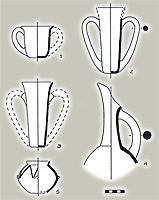Toward the end of the Early Cycladic II and Early Helladic II periods (2450/2350-2200/2150 BC) elements encountered for the first time appear in the architecture, pottery and metalworking of the Cyclades and Central and South mainland Greece. These have parallels with the respective north and eastern Aegean arts (Troy II-late, Poliochni Red-Yellow). A group of researchers associate these parallels with population movements from the north Aegean and west Asia Minor toward the Cyclades which gradually led to the formation of a common culture in the Aegean described with the term "international spirit". Elements of this phase, known as Lefkandi I-Kastri phase, are indicated on Skyros (Palamari), on coastal Thessaly (Pefkakia), in Boeotia (Lithares), on coastal settlements and cemeteries of eastern Attica (Agios Kosmas), of western Euboea (Lefkandi, Manika) and the Argolid (Lerna, Tiryns), on Aegina and in settlements of the Cyclades (Kastri on Syros, Panormos and Zas Cave on Naxos, Skarkos on Ios). Features of this so-called "orientalizing" phase are the fortifications of the Early Cycladic settlements (Kastri on Syros, Panormos on Naxos), the handmade red and black burnished pottery, the use of the potter's wheel for the first time in the Aegean and the particular development of bronze metalworking which is considerably developed in the north Aegean from the beginning of the 3rd millenium BC. Typical vase shapes of this period are the one or two-handled cups, the depata amphikypella and the beak-spouted or wide-mouthed jugs with a globular body. The potter's wheel is used in the manufacture of open bowls. Finally, in metalworking, the archaeometric study of bronze objects from the Cyclades (Kastri) verifies the use of tin bronze alloys of the same composition with the ones used in Troy and Poliochni on Lemnos.
|
 |
|
|
Vase shapes of the Lefkandi I phase
from Kastri on Syros. |
||